Tactical batons are handy self-defense tools that work by giving you a way to protect yourself without causing major harm to an attacker. They come in types like expandable ones that snap out quickly and collapsible options that fit in your bag. You can use them for striking, blocking, or keeping distance from a threat. Made from strong materials like aluminum and polymer, they're built to last. Knowing how to handle a baton is key, so practicing techniques like downward strikes and defensive moves is super important. Stick around to discover more about using these tools effectively!
Overview of Tactical Batons
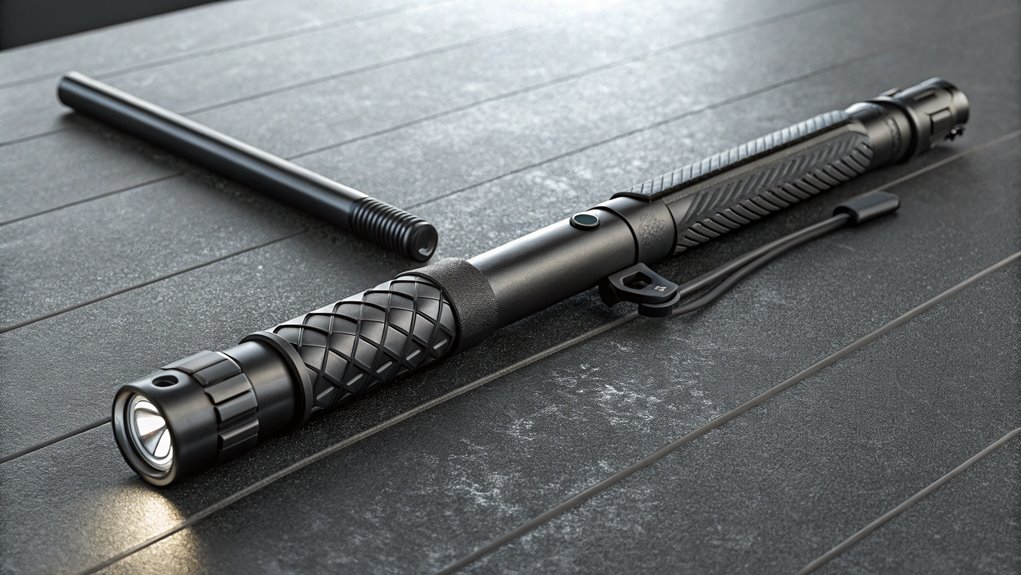
Tactical batons are versatile self-defense tools designed for law enforcement and personal protection. They've got a rich tactical baton history, dating back centuries, where they were used by police officers and military personnel.
You mightn't realize how effective these tools can be for self-defense, but their design allows you to defend yourself without causing severe harm to an attacker. The telescopic steel baton, which expands with a flick of the wrist, is a popular choice for many due to its quick deployment capabilities.
When you think about self-defense effectiveness, a tactical baton stands out because it offers a balance between control and impact. You can use it to create distance between you and a potential threat, striking at vulnerable areas to disable an assailant.
Plus, they're easy to carry and can be quickly deployed, giving you an advantage in critical situations.
Imagine walking home late at night and feeling nervous; having a tactical baton in your bag can boost your confidence. It's not just about being tough; it's about being smart and prepared.
Automatic Expandable Steel Batons come in different lengths, such as 21 inches and 31 inches, providing flexibility depending on your specific needs.
With a little practice, you'll feel empowered to use it effectively. So, whether you're looking to protect yourself or just want to feel safer, a tactical baton might be the right choice for you!
Types of Tactical Batons
When it comes to choosing a baton for self-defense, you'll find several types, each designed for specific situations and preferences. The most common options are expandable and collapsible batons. Each type has unique features that can impact your decision.
| Type | Description |
|---|---|
| Expandable Batons | These batons extend with a flick of the wrist, making them easy to deploy in a hurry. They usually lock into place for a firm grip. Perfect for quick access! |
| Collapsible Batons | Collapsible batons are compact and can easily fit in your bag or pocket. They require a bit more effort to deploy but can be great for discreet carry. |
Choosing the right baton depends on your comfort level and how you plan to use it. If you want something quick to access, an expandable baton might be the way to go. On the other hand, if you prefer something more portable, a collapsible baton could suit your needs. Remember, it's essential to select a baton that you can handle effectively, ensuring you feel confident in your self-defense strategy. Your safety matters! Additionally, some batons come with added features like a convenient belt clip and key ring for easy access, making them versatile self-defense tools.
Materials Used in Construction
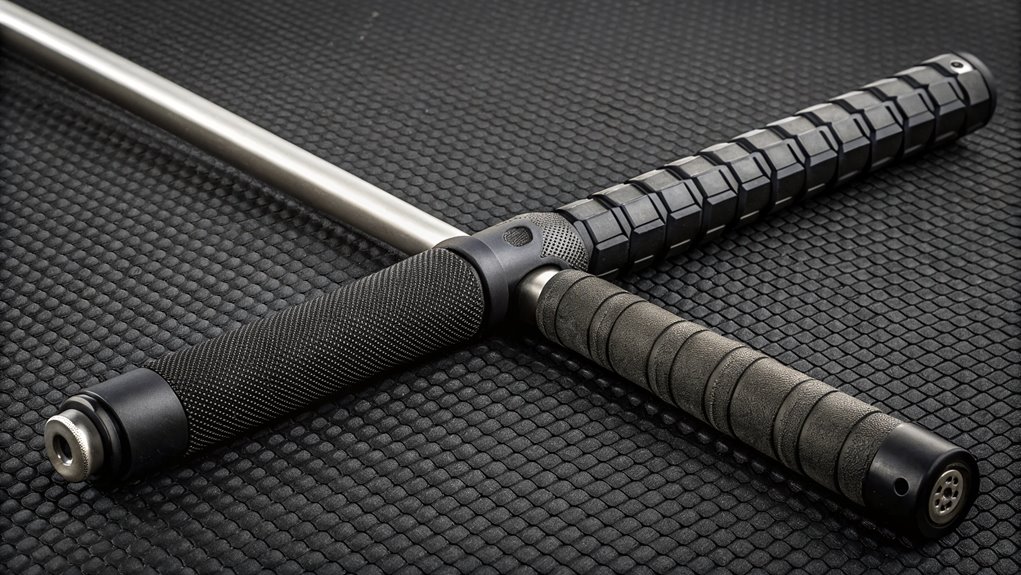
Selecting the right materials for a tactical baton is essential for its performance and durability. You want a baton that can withstand tough situations, and that's where materials like aluminum alloys and polymer composites come into play.
Aluminum alloys are lightweight yet strong, making them perfect for a baton you might need to carry around. They resist corrosion, too, so you won't have to worry about wear and tear from the elements.
On the other hand, polymer composites offer incredible flexibility and impact resistance. These materials can absorb shock better than metal, which means they can help prevent injury to both you and your target in a defensive situation.
The combination of these materials can give you a baton that feels good in your hands and performs exceptionally well when it counts.
When you're choosing a tactical baton, think about how often you'll use it and what kind of situations you might face. A well-constructed baton, made from the right materials, can be an essential tool for self-defense and personal safety, helping you feel secure no matter where you are.
Basic Techniques for Use
Mastering the basic techniques for using a tactical baton is essential for effective self-defense. You need to familiarize yourself with striking techniques that can help you defend against an attacker.
For example, a simple downward strike can deliver a powerful blow to an opponent, while a side strike can catch them off-guard. Practice these moves until they feel natural, as you want to be quick and confident in a tense situation.
In addition to striking, you should also learn some defensive maneuvers. This means knowing how to block incoming attacks and create distance between you and the threat.
A basic block can deflect an incoming punch, while a quick retreat can give you time to think and plan your next move.
Advanced Techniques and Strategies
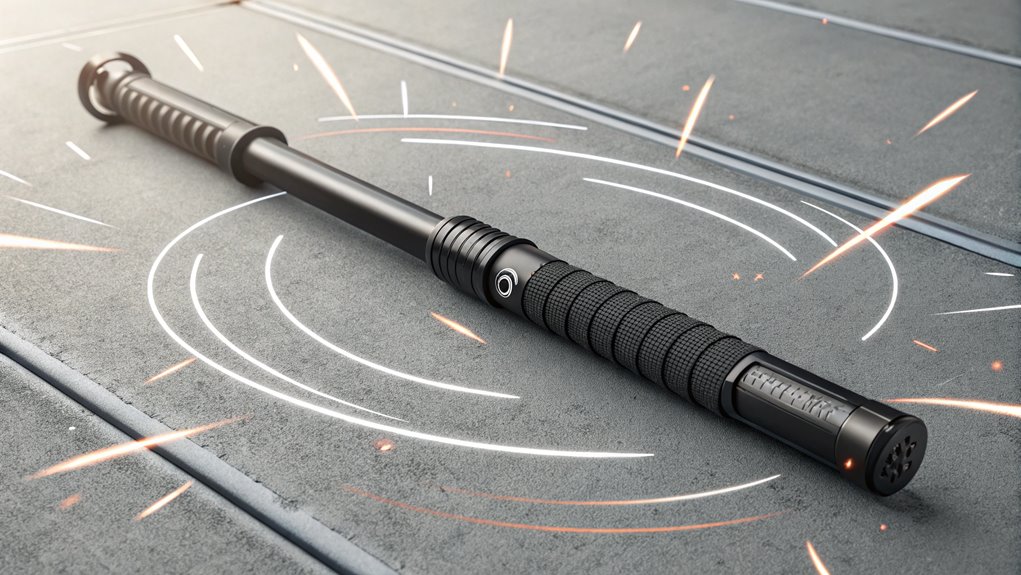
After you've grasped the basic techniques, it's time to expand your skill set with advanced techniques and strategies for tactical baton use.
You'll want to focus on strategic positioning, which means knowing where to stand in relation to your opponent. This helps you control the situation, making it harder for them to reach you while also giving you the advantage to strike effectively.
One advanced defensive maneuver involves using the baton to create a barrier. By holding it out in front of you, you can deflect incoming attacks while maintaining your balance.
Another technique is the spin, where you rotate the baton around your body to confuse your opponent and create openings for counter-attacks.
Practice these moves regularly, so they become second nature. Remember, the goal is to stay safe and control the situation, not to escalate it.
Always be aware of your surroundings, and think ahead about possible escape routes. By mastering these advanced techniques, you'll boost your confidence and effectiveness in self-defense scenarios, ensuring you're ready for whatever comes your way.
Your safety matters, so keep training and stay sharp!
Legal Considerations and Regulations
When it comes to using a tactical baton, understanding the legal considerations and regulations is crucial. You need to be aware of the legal implications of carrying and using a baton in your area because laws can vary widely from one place to another. For instance, some states allow the use of tactical batons for self-defense, while others may restrict or even ban them outright.
So, before you decide to carry one, make certain you know your local laws!
Regulatory requirements also play a significant role in how you can use a tactical baton. Training may be required in some jurisdictions to guarantee that you use the baton responsibly and effectively. Knowing how to handle a baton not only keeps you safe but also helps you stay within legal boundaries.
If you ever need to use it in a self-defense situation, being informed about these regulations can protect you from potential legal trouble.
Advantages of Tactical Batons
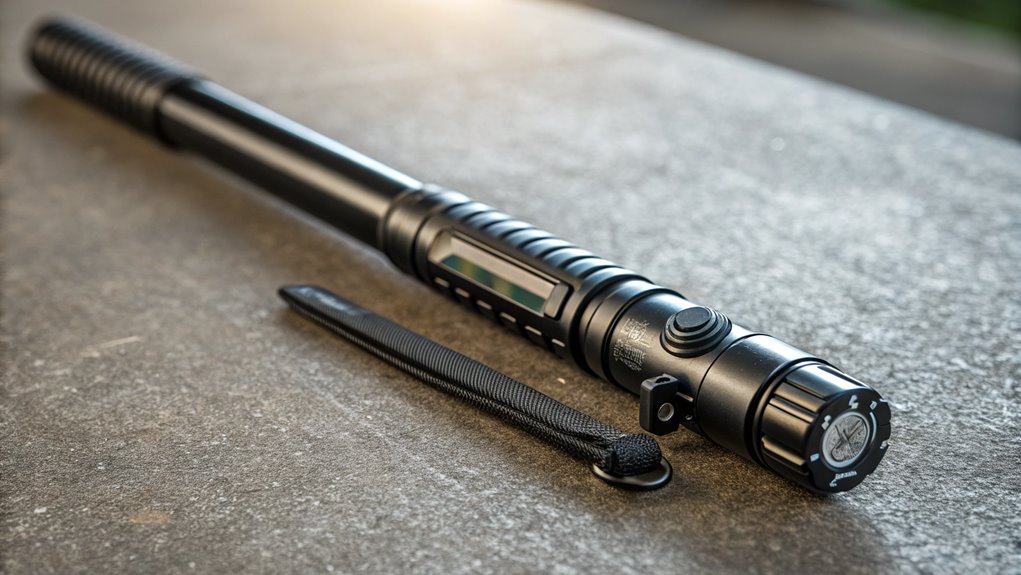
Understanding the legal landscape surrounding tactical batons not only informs your responsibilities but also highlights their advantages. One major benefit is their self-defense capabilities. When faced with a threatening situation, a tactical baton can help you protect yourself without causing serious harm. It's a tool designed to give you an edge, allowing you to create distance from an attacker while maintaining control.
Another great aspect is the tactical versatility of these batons. You can carry them easily and use them in various scenarios, whether you're out for a jog, walking home from school, or just enjoying time with friends. They're lightweight and compact, so you won't feel weighed down.
Plus, they can be used in different ways—striking, blocking, or even as a pressure point tool, depending on the situation. The ability to defend yourself and adapt to different circumstances makes tactical batons a valuable option in your personal safety toolkit.
Plus, if you ever need to use one, having a tactical baton can boost your confidence, knowing you have a reliable way to protect yourself. Remember, staying safe is always the priority!
Maintenance and Care Tips
Proper maintenance and care of your tactical baton can greatly extend its lifespan and guarantee optimal performance.
First off, you should regularly clean your baton to remove dirt and grime. Use a soft cloth with mild soap and water for cleaning; avoid harsh chemicals that could damage the finish. If you notice any rust, gently scrub it away with fine steel wool, then wipe it down with oil to protect against future corrosion.
Next, think about your storage solutions. Always store your baton in a cool, dry place, away from direct sunlight. A padded case or holster can protect it from bumps and scratches, ensuring it's ready when you need it.
If you're carrying it regularly, check it for any signs of wear and tear, like loose parts or dents, and fix them promptly.
Finally, remember to check the locking mechanism, if applicable. A baton that doesn't lock properly can be dangerous.
By following these simple cleaning methods and storage solutions, you'll keep your tactical baton in excellent condition, ready to serve its purpose when you need it most.
Stay safe out there!
Training Resources and Recommendations
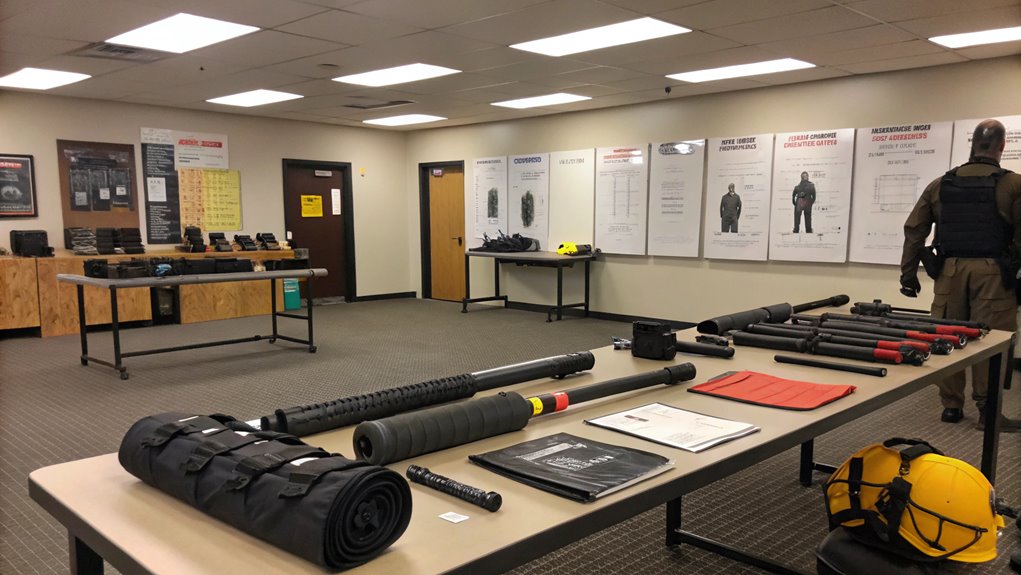
To effectively wield a tactical baton, you need access to quality training resources that enhance your skills and boost your confidence. It's essential to feel prepared, especially when it comes to self-defense. You can find several valuable resources that help you learn the ins and outs of using a tactical baton safely and effectively.
Here's a quick overview of some recommended training materials:
| Resource Type | Description | Where to Find |
|---|---|---|
| Training Videos | Visual demonstrations from experts | YouTube, Vimeo |
| Instructional Manuals | Step-by-step guides with illustrations | Amazon, eBooks |
| Online Courses | Structured lessons with feedback | Udemy, Coursera |
| Local Workshops | Hands-on training with instructors | Community centers |
Answers to Common Questions
Can Tactical Batons Be Used for Self-Defense in All Situations?
Tactical batons can be effective in various self-defense scenarios, but they're not suitable for every situation. You must undergo tactical training to understand when and how to use them safely and effectively.
Are There Age Restrictions for Carrying a Tactical Baton?
Imagine a young knight wielding a baton; age limits vary by location. You need to check local laws, as legal implications can restrict carrying one based on age. Stay informed to avoid potential issues.
What Should I Do if My Baton Gets Damaged?
If your baton gets damaged, assess the extent of the damage first. For minor issues, consider baton maintenance techniques; for severe damage, explore repair options or replace it to guarantee your safety and effectiveness.
How Do I Choose the Right Size Baton for Me?
Choosing the right size baton involves considering baton length and grip comfort. Make sure it's long enough for effective reach but short enough for easy handling. Test different sizes to find what feels best for you.
Can I Legally Carry a Tactical Baton in Public Spaces?
"Better safe than sorry," but whether you can legally carry a tactical baton in public spaces depends on your local legal regulations. Always prioritize public safety and check laws to avoid unwanted consequences.
Bottom Line
To sum up, knowing how to use a tactical baton can really boost your personal safety. Did you know that around 70% of self-defense situations can be resolved without serious violence when you have the right tools? That's pretty powerful! Whether you're looking to protect yourself or just want to feel more confident, understanding the basics and practicing regularly can make a huge difference. So, stay informed, stay safe, and remember: knowledge is your best defense!




